Fryeria or Phyllidia?
Order: NUDIBRANCHIA
Suborder: DORIDINA
Superfamily: EUDORIDOIDEA
Family: Phyllidiidae
Here are some messages about animals with a ventral anus, as in Fryeria but with a black median line on the sole of the foot, which is usually only found in some species of Phyllidia. They are either aberrant specimens of one or more species of Phyllidia or a unnamed species of Fryeria with a very variable colour pattern.
Authorship detailsRudman, W.B., 2002 (March 26) Fryeria or Phyllidia? [In] Sea Slug Forum. Australian Museum, Sydney. Available from http://www.seaslugforum.net/find/fryephyl
Related messages
Fryeria or Phyllidia from Hachijo Ids Japan
March 28, 2002
From: Shouichi Kato
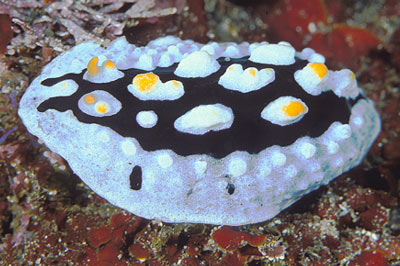
Dear Bill,
I found it in about 30 meters diving area of Hachijo Iland in Japan. About 5cm in size
Firstly, I thought it might be Phyllidia varicosa because it was very similar to one in the picture attached to Lindsay Warren's letter dated on April 8 2001.
But I confirmed the position of their anus was below the mantle skirt in the posterior midline, suggested this species a kind of Fryeria. Is he Fryeria menindie or Fryeria sp.? I also wonder if Fryeria menindie has sometimes a black longitudial foot stripe on their foot sole as shown in my picture.
Looking forward your comment.
Thanks and best regards,
S. Kato
regulus@tokyo7.ne.jp
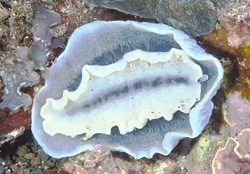
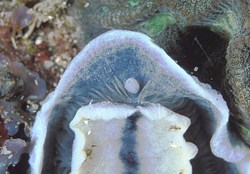
Dear Souicho,
This certainly helps to confuse the situation about Fryeria and Phyllidia and appropriately I am posting it with Terry Gosliner's and Angel Valdes's messages on the subject.
As you say it looks like Lindsay Warren's animal which looks like Phyllidia coelestis but like your animal has a median black stripe on the sole of the foot. As far as we know only Phyllidia varicosa, Phyllidia elegans , Phyllidia carlsonhoffi and Phyllidia tula have a black line on the sole.
More difficult to explain is the ventral anus which is so well illustrated in your photo. As far as I know no species of Fryeria is reported to have a black line on the foot. Lindsay Warren does not mention the position of the anus in her animal, but it could easily have been ventral. Checking through other messages I have found a couple of photos from Yasman [message 1; message 21] which could easily be the same animal. I have put them all together on a page entitled Fryeria or Phyllidia?.
Basically I don't know whether they are aberrant species of Phyllidia in which the anus is ventral or a new species of Fryeria with a black line on the sole. I don't even think it would help us interpret the situation if we considered that species of Fryeria were actually species of
Thanks for this intresting find. Sorry I can't provide an easy answer,
Bill Rudman
Phyllidia coelestis? from Sulawesi
April 8, 2001
From: Lindsay Warren
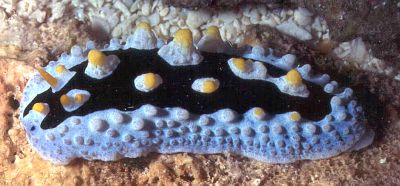
Dear Bill
I wonder whether you might be able to shed some light on the attached phyllidiid. We have found two specimens with the same markings. They look very similar to Phyllidia coelestis (including Y shaped mark in front of the rhinophores) but they have a black line along the centre of the foot.
They are considerably larger than 'regular' P. coelestis which we find fairly regularly in the Tukang Besi Archipelago. This particular one was found on 7 August 1999 on Pulau Hoga at a depth of 14 m on dead coral and coralline algae. Size: 49 mm. Photo: Lindsay
Warren. [Operation Wallacea]
Looking forward to your comments.
All the best
Lindsay
alldcl@compuserve.com
Warren, L., 2001 (Apr 8) Phyllidia coelestis? from Sulawesi. [Message in] Sea Slug Forum. Australian Museum, Sydney. Available from http://www.seaslugforum.net/find/4130Phyllidia varicosa, Phyllidia elegans , Phyllidia carlsonhoffi and Phyllidia tula all have a median black line on the foot sole, but none look very like your animal. Unless it is an undescribed species, my guess is that it is a form of Phyllidia varicosa or perhaps P. coelestis can have a black line on the foot as well?
Best wishes,
Bill Rudman
Fryeria (?) with black line on sole
December 30, 2000
From: Yasman
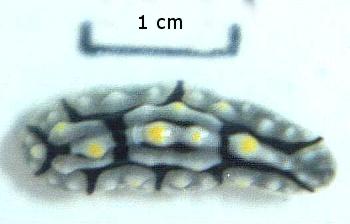
Dear Bill,
At first, I thought that this was Phyllidia varicosa. After I took to the lab, I found this species has anus at the ventral (posterior) which is typical to genus of Fryeria. The black pattern on the blue grey back ground of body is also different from Phyllidia varicosa. But it is amazing that it has black line on the foot sole which typical for Phyllidia varicosa. What do you think??
Regards,
Yasman
y.yasman@mailcity.com
Yasman, 2000 (Dec 30) Fryeria (?) with black line on sole. [Message in] Sea Slug Forum. Australian Museum, Sydney. Available from http://www.seaslugforum.net/find/3337Dear Yasman,
It certainly looks like a juvenile Fryeria marinidica or a Phyllidia elegans. The position of the anus certainly suggests Fryeria. However the black line on the sole makes me think that you should look at its anatomy. There are differences described by Brunckhorst (1993) in the anatomy of the foregut and the reproductive system.
It is possible that the position of the anus is a result of damage to the body, perhaps by a fish. I was amazed in Lifou at how many of the phyllidiid specimens had considerable damage - mainly to the head end, sometimes resulting in one rhinophore, or a large shared rhinophore pocket. For animals with such an armoury of chemicals, some fish were evidently slow learners.
However, until you can confirm what genus your species belongs to there doesn't seem much point in speculating over whether you have a Phyllidia with an anus in the wrong place or a Fryeria with a black line on its sole. It is an interesting find.
Best wishes,
Bill Rudman
Phyllidia coelestis (?) with black line on sole
December 28, 2000
From: Yasman
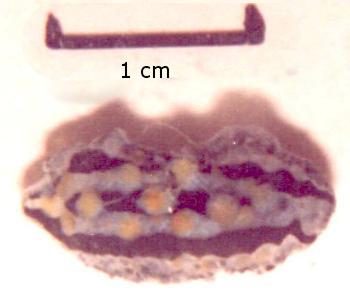
Dear Sir,
I quite wonder to identify this species. This species I found in Karang Lebar Atoll, Thousand Islands, Indonesia. In general, it looks like Phyllidia coelestis even though the 'Y' shape does not exist. But it has 3 black bands and also has tubercle form and pattern like Phyllidia coelestis. In addition, I found the juvenile of Phyllidia varicosa which look like very similar to the adult pattern. So, I think it should not be juvenile of Phyllidia varicosa. It is amazing, however, because it also has black line at the foot sole. This character belongs to the species Phyllidia varicosa, not Phyllidia coelestis. What do you think?
Regards,
Yasman
y.yasman@mailcity.com
Yasman, 2000 (Dec 28) Phyllidia coelestis (?) with black line on sole. [Message in] Sea Slug Forum. Australian Museum, Sydney. Available from http://www.seaslugforum.net/find/3334Dear Yasman,
As you say, the photo of the dorsal surface certainly looks like Phyllidia coelestis. I don't know another species with a dorsal median black band. However your mention of a median black line on the sole is very puzzling. As far as I know only four species have a median longitudinal black line on the sole:
Phyllidia varicosa, Phyllidia tula, Phyllidia elegans, Phyllidia carlsonhoffi.
None of these has a dorsal coloration like your animal. At this stage I would tentatively identify as P. coelestis. I think we still have some work to do on the presence and absence of the black line on the sole of the foot of these species. Unfortunately this character is usually not recorded (and seldom photographed), so it is difficult to accumulate information. I found some puzzling black lines in specimens in Lifou, which when I get a chance I must try and make sense of.
Best wishes,
Bill Rudman.
